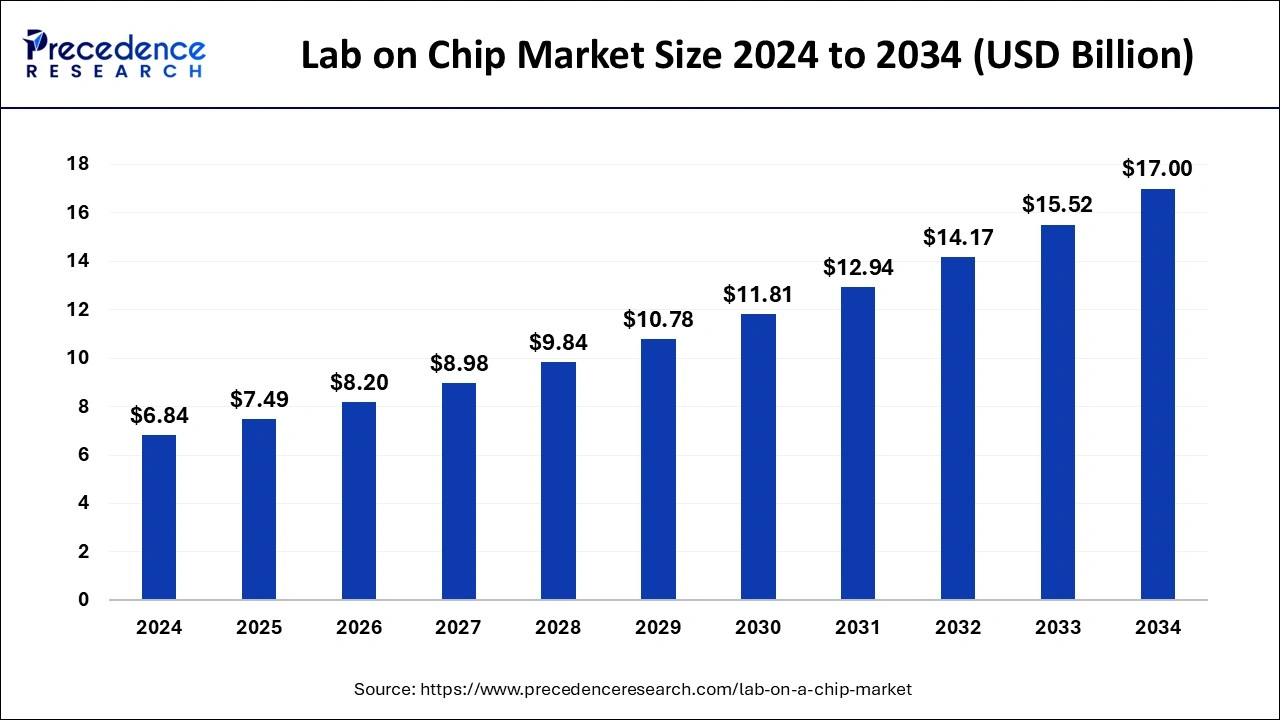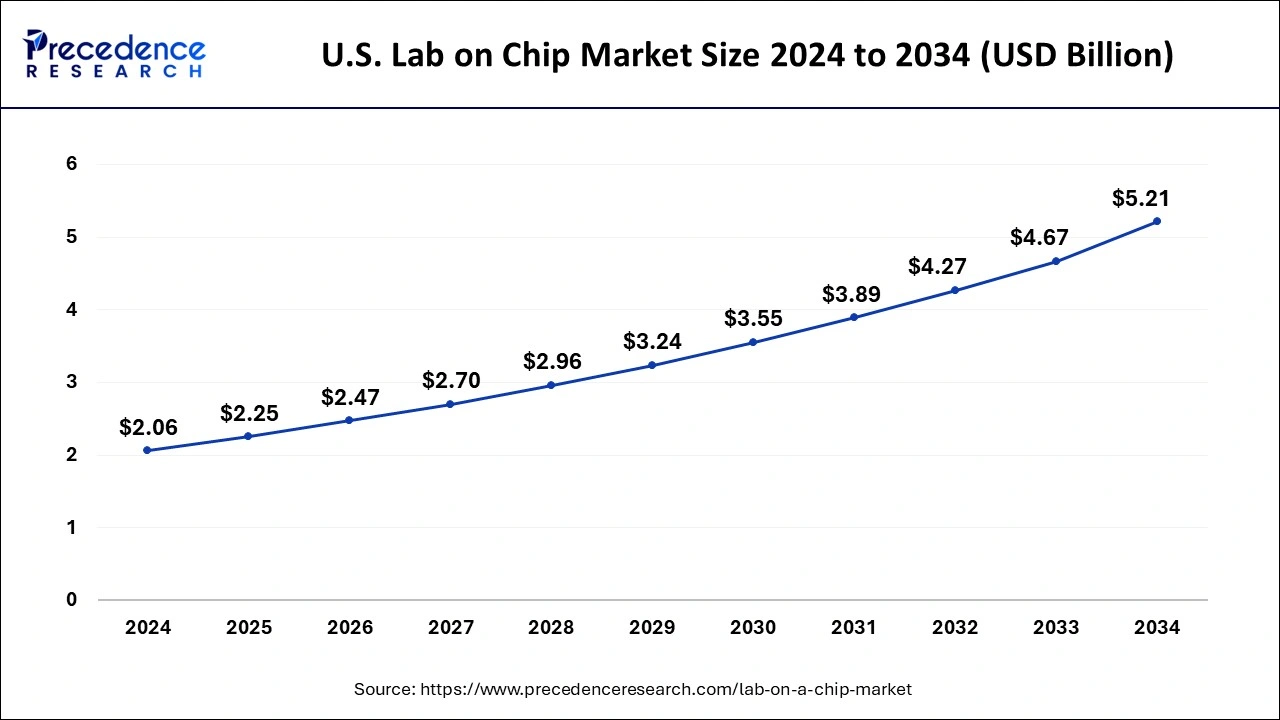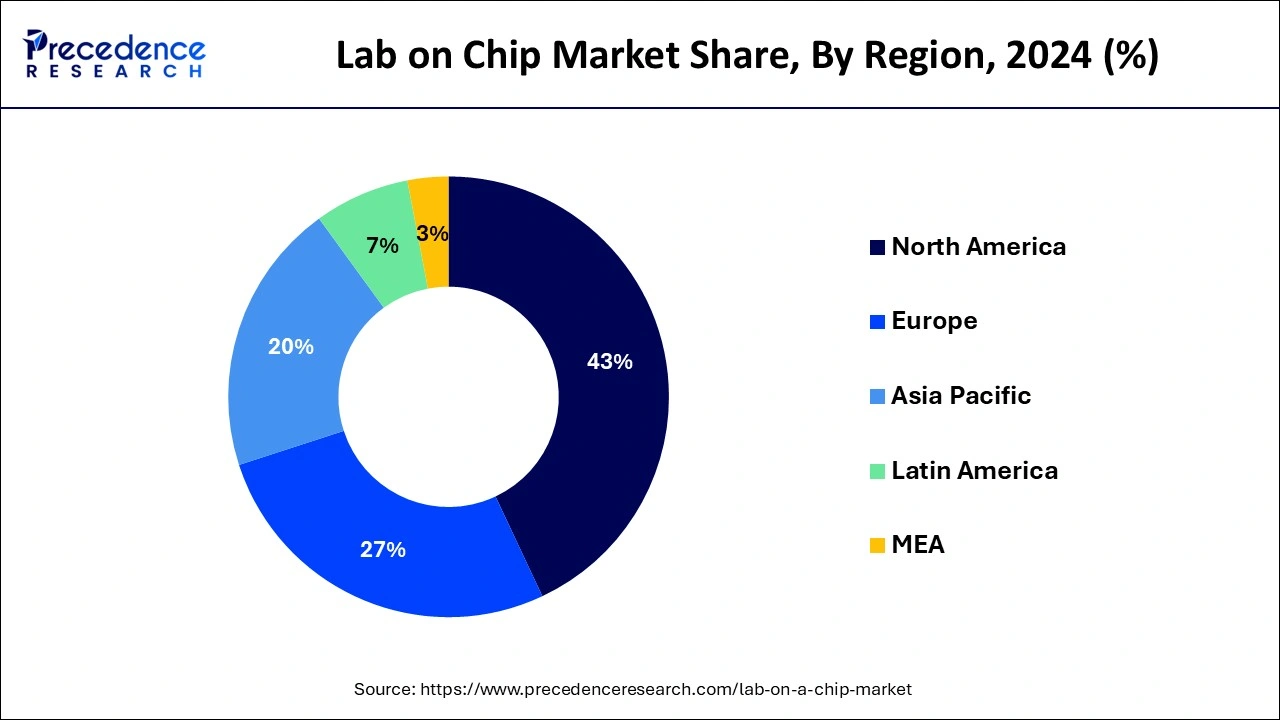July 2024
The global lab on chip market size is accounted at USD 7.49 billion in 2025 and is forecasted to hit around USD 17.00 billion by 2034, representing a CAGR of 9.54% from 2025 to 2034. The North America market size was estimated at USD 2.94 billion in 2024 and is expanding at a CAGR of 9.67% during the forecast period. The market sizing and forecasts are revenue-based (USD Million/Billion), with 2024 as the base year.
The global lab on chip market size accounted for USD 6.84 billion in 2024 and is expected to exceed around USD 17.00 billion by 2034, growing at a CAGR of 9.54% from 2025 to 2034. The lab on chip market is growing rapidly due to the rising healthcare diagnosis facilities.

The integration of AI in the lab on chip market helps to bring revolution to this sector and by advanced diagnosis process. The major role of AI in this market is to improve the analysis of data and its interpretation. This device is used to generate huge amounts of data from the samples that are present in complex forms, and AI can help to understand that information in a simplified way possible. AI plays an important role in the automation of processes in the lab-on-chip system.
The U.S. lab on chip market size was evaluated at USD 2.06 billion in 2024 and is projected to be worth around USD 5.21 billion by 2034, growing at a CAGR of 9.67% from 2025 to 2034.

The global lab on ship market had accounted for the largest revenue share through North America. An increased adoption of advanced technologies, research and development and investments by various pharmaceutical companies in this domain has led to a growth in the market. As a great number of leading firms, providing the lab on chip is located in the North American region. It is also expected to contribute to the growth in the revenue of this region.
The Asia Pacific market is also expected to see faster growth for the lab and ship market during the forecast period as there are developments in the healthcare infrastructure and the diseases, like the renal diseases, which are prevalent in this region. Also, the increased cardiovascular diseases and government initiatives in this region are leading to a growth in the market. The increasing geriatric population and the demand for the regenerative medicines is another reason why the market is expected to grow during the forecast.
The lab on chip devices is nothing but the miniaturization of laboratory procedures and an integration of various disciplines. These devices are used in various branches of the healthcare segments like the drug delivery, synthetic biology, stem cells, environmental monitoring etc an increased use of lab on chips in the chronic diseases is leading to a growth in the market. Little prevalence of expensive health problems and an increase in the geriatric population, the market is expected to grow. The lab on chip device is able to scale down singular, multiple laboratory functions into a chip format where the chip size is approximately millimeters to a few square centimeters.
| Report Coverage | Details |
| Market Size in 2025 | USD 7.49 Billion |
| Market Size in 2034 | USD 17.00 Billion |
| Growth Rate from 2025 to 2034 |
CAGR of 9.54% |
| Largest Market | North America |
| Fastest Market | Asia Pacific |
| Base Year | 2024 |
| Forecast Period | 2025 to 2034 |
| Segments Covered | Product, Technology, Application, End-Use, Geography |
| Regions Covered | North America, Europe, Asia-Pacific, Latin America, and Middle East & Africa |
Demand for digitization in lab testing
Lab on chip devices offer more cost-effective and efficient tools for diagnostics. Lab on chip devices offer faster results and are accessible to minimally trained technicians. These are particularly useful in point-of-care and emergency settings where quick and accurate diagnostics are pivotal in administering medical treatment. Growing trends in personalized medicine are also fuelling demand for lab on chip devices for measurements of biomarkers and other crucial health indicators.
High research and development cost
The high investment costs behind lab on chip devices, including the integration of several functions on a single chip, lead to high costs of production and, in turn, costs to patients and healthcare providers. Stringent government regulations around the use of such devices also lead to high in-market costs for companies. The materials and synthesis costs associated with lab on chip devices are also costly and require technical expertise.
Integration and machine learning with LOC devices
There are several opportunities for growth in the lab on chip market due to advancements in biomedical science, fuelled by the integration of artificial intelligence and machine learning. The development of LOC capabilities in wearable smart health devices and increasing continued demand for real-time health data processing are expected to spur demand in the coming years in the market.
On the basis of technology, the lab on chip market is segmented into microfluidics and micro arrays. There's an increased application of microfluidics which is responsible for the shift from the conventional laboratory procedures to a lab on chips. In order to manufacture varied consumer products, microfluidics has been used extensively and it is expected to have a great application in many regions or areas. They help in reducing errors in cost management and offer a good return on the investments.
Laboratories use microarray as a tool to detect many genes at the same time due to increased advancements in this technology, the adoption of microarrays is expected to grow during the forecast. Increase of biochips in the treatment and diagnosis of cancer and providing personalized medicine will help in the growth of the microarray segment. The microfluidic lab on Chip has great potential in order to revolutionize the biomedical stream and provide for the growth of the healthcare sector. The microfluidic platform helps in the automation of biochemical assays, favoring the lab on chip device over traditional tests in research laboratories integration miniaturization etc.
The various applications of lab and ship technology in the biomedical field and immunoassay lab on chip for bacteria detection, DNA chip, gene chip, cellular analysis, chip flow, cytometer lab on chip which is used in order to detect HIV. The lab and ship market on the basis of application can be segmented into genomics, proteomics, drug discovery and diagnostics. Good growth opportunity is provided by the Proteomics Lab on chip as it helps to perform protein analysis. It also has a great potential for crystallization of protein, which is an important field that helps in revealing the structures of a protein. Researchers are able to gain greater control and faster ways to cover all the parameters which help in the crystallization of protein with the help of a lab on chip. Lab on chip also helps in RNA and DNA sequencing in the future. These opportunities for sequencing of DNA and RNA are expected to grow during the forecast.
In order to detect the virus and bacteria with the help of a lab on chip which has the biomolecular operations has an enormous possibility and it is expected to grow during the forecast. Lab and ship is able to sequence genomes many times faster for any kind of DNA probes. The advances in the field of computational simulations have also made it possible to produce inorganic nanomaterials. Based on nanomedicine using lab on shift technology the lab on chip devices are also used for biomarker based identification which helps in detecting oral cancer in the early stages and increases the survival rate.
The reagents & consumables segment registered its dominance over the global market. Reagents and consumables are used in every instance of diagnostic testing administered with lab on chip devices. There is a high demand for state-of-the-art reagent kits due to an increase in diagnostic testing and investment in research and biotechnology. These reagents are used regularly for conducting various analyses and assays, leading to this high demand.
The software segment is predicted to witness significant growth in the market over the forecast period. The increasing sophistication of lab on chip devices means frequent software and hardware updates. Future devices are expected to be streamlined and optimized with software rather than changing devices completely. This is expected to propel growth in the market in the coming years.
The hospitals and clinics segment dominated the global market. The increasing use of lab on chip devices in hospital settings, especially with applications in the ER, point-of-care medicine, and quicker diagnoses for treatment, is fuelling demand. Hospitals have larger budgets for adopting new innovative technologies, where they are required on a large scale. This allows businesses opportunities to scale their operations.
The biotechnology and pharmaceutical companies segment is predicted to witness significant growth in the market over the forecast period. The increasing testing standards in biotech and pharmaceutical labs are expected to lead to the growing adoption of lab on chip devices in this segment. Increasing investment in healthcare and biomedical research is expected to boost future demand for lab on chip devices.
By Product
By Technology
By Application
By End-Use
By Geography
For inquiries regarding discounts, bulk purchases, or customization requests, please contact us at sales@precedenceresearch.com
No cookie-cutter, only authentic analysis – take the 1st step to become a Precedence Research client
July 2024